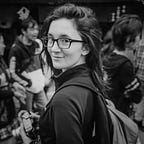“Foreigners” at Cortona on the Move
From August 13th until the 17th I attended the Cortona On the Move Photography Festival (COTM) in Cortona, Italy. Here are some of the photography exhibits and workshops that interested me the most.
Daniel Castro Garcia’s, Foreigner, stands alone as an exhibition. Utilizing a variety of styles of shooting and image presentation, Foreigner, has the feeling of a photographer trying to understand his subject dynamically and maturely, keeping viewers engaged and constantly trying to understand the people and stories they are seeing.
Foreigner, is Garcia’s epic investigation of the refugee crisis across Europe since 2015 and “presents a selection of images from [his] book [‘Foreigner: Migration into Europe 2015–2016’], but also new portraits, interviews and film footage taken in the beginning of 2017.” In addition, Garcia also utilizes articles written for his small newspaper-style book Foreigner: Collected Writings 2017, which has the effect of slowing the viewer down as they move through the exhibit. These writings also give context to the personal images you are seeing on a wider social level.
The first thing I am struck by in the Foreigner exhibition is the shear scope of it. Garcia does not just utilize documentary and photojournalistic methods of image making, but also installation and fine art styles, as well as video multimedia work.
Foreigners is housed by COTM in an old hospital in Cortona and utilizes the space effectively, using the aged white tile and slightly off colored white walls to emphasize the homeless transience of refugees as they flea their countries to Europe. The first room of the exhibition is presented as a wider study of the refugee issue in Europe and a series of black and white images is presented to “show [Garcia’s] own hypocrisy regarding the story.” That hypocrisy being the trap that Garcia felt he fallen into by taking the more mainstream photojournalistic images, which he found to be more sensationalistic. “By including them I am hoping to offer a dramatic contrast. Ultimately people have connected most to my portraits, Madia, Aly (two men highlighted in the project) etc… people have taken more from them than the black and whites.”
Garcia remembers making an image of a mother and her child as she comes into Europe from a makeshift raft full of refugees and the hale of photographic gunfire that came after he made the images, creating the sensation the photojournalists were taking from these people, rather than engaging with them or giving anything back.
Garcia then goes on to portray refugees throughout their journey, meeting up with people in numerous different locations, including a young Syrian girl as she fleas to Germany across Europe.
The second room of Garcia’s exhibition takes on a considerably more personal feel as he focuses on installation photography and portraiture, and strikes up a collaborative friendship with two men from Northern Africa. The first, Aly (or Gucci as he is known by his friends), partnered with Garcia for a series of portraits and a beautiful video piece accompanied Garcia to the exhibition and festival. Aly brings a new level of intimacy to the exhibition and festival overall.
The video installation created by Aly and Garcia examines Aly’s journey to Italy from Senegal and his subsequent 3–4 year wait for work papers in an intense and intimate manner, jumping between three-panel and one-panel projections to emphasize different aspects of storytelling and mirror’s Aly’s memories with images of the natural world.
The second story is of Madia, who watched his friend get shot in the head while they were traveling together to Europe and has been haunted by the image ever since. Where the video with Aly is more visually dynamic, the projection with Madia is simple and direct, showing only Madia face at various angles, eyes occasionally open and shut, repeating the refrain, “I was there. I saw it. I am a witness.” It is enough to drive you to tears in its intense simplicity.
Madia’s projection is also matched with a multimedia portrait depicting Madia wearing mesh in the upward shape of a cone (originally intended to hold a bouquet of flowers) on top of his head. “This is what it looked like.” Garcia reports of Madia’s memory of his friend’s death. Dropping from the photograph are gently sewn red threads cascading to the exhibition floor, as if the photograph itself is bleeding. The image is a centerpiece to the exhibit.
Garcia’s exhibit was easily the most complex and dynamic of the festival and served the event well by push the boundaries of how we in the photographic community address pertinent social stories in new and dynamic ways.
